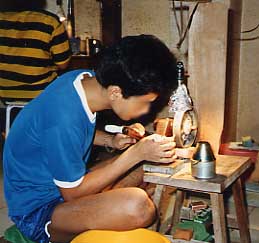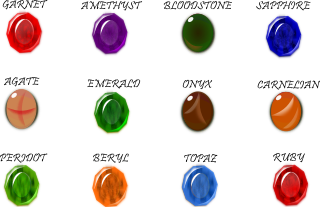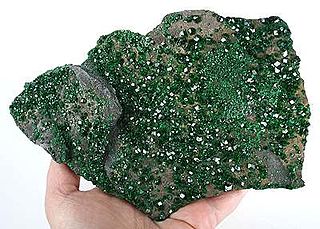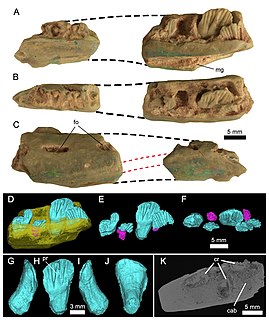
Costume jewelry includes a range of decorative items worn for personal adornment that are manufactured as less expensive ornamentation to complement a particular fashionable outfit or garment as opposed to "real" (fine) jewelry, which is more costly and which may be regarded primarily as collectibles, keepsakes, or investments.

A gemstone is a piece of mineral crystal which, in cut and polished form, is used to make jewelry or other adornments. However, certain rocks and occasionally organic materials that are not minerals are also used for jewelry and are therefore often considered to be gemstones as well. Most gemstones are hard, but some soft minerals are used in jewelry because of their luster or other physical properties that have aesthetic value. Rarity is another characteristic that lends value to a gemstone.

Jewellery or jewelry consists of decorative items worn for personal adornment, such as brooches, rings, necklaces, earrings, pendants, bracelets, and cufflinks. Jewellery may be attached to the body or the clothes. From a western perspective, the term is restricted to durable ornaments, excluding flowers for example. For many centuries metal such as gold used in different carats from 21, 18, 12, 9 or even lower, often combined with gemstones, has been the normal material for jewellery, but other materials such as shells and other plant materials may be used. It is one of the oldest type of archaeological artefact – with 100,000-year-old beads made from Nassarius shells thought to be the oldest known jewellery. The basic forms of jewellery vary between cultures but are often extremely long-lived; in European cultures the most common forms of jewellery listed above have persisted since ancient times, while other forms such as adornments for the nose or ankle, important in other cultures, are much less common.

Topaz is a silicate mineral of aluminium and fluorine with the chemical formula Al2SiO4(F, OH)2. Topaz crystallizes in the orthorhombic system, and its crystals are mostly prismatic terminated by pyramidal and other faces. It is one of the hardest naturally occurring minerals (Mohs hardness of 8) and is the hardest of any silicate mineral. This hardness combined with its usual transparency and variety of colors means that it has acquired wide use in jewellery as a cut gemstone as well as for intaglios and other gemstone carvings.

A ruby is a pink to blood-red coloured gemstone, a variety of the mineral corundum. Other varieties of gem-quality corundum are called sapphires. Ruby is one of the traditional cardinal gems, together with amethyst, sapphire, emerald, and diamond. The word ruby comes from ruber, Latin for red. The color of a ruby is due to the element chromium.

Opal is a hydrated amorphous form of silica (SiO2·nH2O); its water content may range from 3 to 21% by weight, but is usually between 6 and 10%. Because of its amorphous character, it is classed as a mineraloid, unlike crystalline forms of silica, which are classed as minerals. It is deposited at a relatively low temperature and may occur in the fissures of almost any kind of rock, being most commonly found with limonite, sandstone, rhyolite, marl, and basalt.
Lustre or luster is the way light interacts with the surface of a crystal, rock, or mineral. The word traces its origins back to the Latin lux, meaning "light", and generally implies radiance, gloss, or brilliance.

A gemcutter is a person who cuts, shapes, and polishes natural and synthetic gemstones. In historical use it usually refers to an artist who made hardstone carvings or engraved gems, a branch of miniature sculpture or ornament in gemstone.
In modern Western body piercing, a wide variety of materials are used. Some cannot be autoclaved, and others may induce allergic reactions, or harbour bacteria. Certain countries, such as those belonging to the EU, have legal regulations specifying which materials can be used in new piercings.
Diamond enhancements are specific treatments, performed on natural diamonds, which are designed to improve the visual gemological characteristics of the diamond in one or more ways. These include clarity treatments such as laser drilling to remove black carbon inclusions, fracture filling to make small internal cracks less visible, color irradiation and annealing treatments to make yellow and brown diamonds a vibrant fancy color such as vivid yellow, blue, or pink.
Jewelry cleaning is the practice of removing dirt or tarnish from jewelry to improve its appearance.

A doublet is a type of assembled gem composed in two sections. It is sometimes used to imitate other, more expensive gems.

Ammolite is an opal-like organic gemstone found primarily along the eastern slopes of the Rocky Mountains of North America. It is made of the fossilized shells of ammonites, which in turn are composed primarily of aragonite, the same mineral contained in nacre, with a microstructure inherited from the shell. It is one of few biogenic gemstones; others include amber and pearl.1 In 1981, ammolite was given official gemstone status by the World Jewellery Confederation (CIBJO), the same year commercial mining of ammolite began. It was designated the official gemstone of the City of Lethbridge, Alberta in 2007.

A birthstone is a gemstone that represents a person's month of birth. Birthstones are often worn as jewelry or as a pendant necklace.
Foilbacks, in vintage jewellery, is the practice of inserting metal foil behind gemstones or faux gemstones to enhance their sparkle and reflective properties. When this foil darkens or peels, these gemstones are often considered dead or lacking in sparkle. Modern jewelers seldom use foiling behind actual gemstones, but faux gems are made in a similar fashion even today.

Slocum stone is an early opal simulant which was briefly popular prior to the introduction of synthetics and less expensive simulants. It was named after its inventor, John S. Slocum (1920-1998) of Rochester, Michigan.

Marcasite jewelry is jewelry made using cut & polished pieces of pyrite as gemstone, and not, as the name suggests, from marcasite.

In geology, druse, also known as drusy or druzy, refers to a coating of fine crystals on a rock fracture surface, vein or within a vug or geode.

The Shelby Gem Factory, also known as ICT Incorporated, was a Michigan company that manufactured artificial gemstones through proprietary processes. The factory made more varieties of man-made gemstones than any other in the world. It grew artificial gems and gem simulants, including synthetic ruby and sapphire and simulated diamonds, citrine, topaz, and other birthstone substitutes, and mounted them in gold or silver jewelry.

Weewarrasaurus is a genus of ornithopod dinosaur from the Late Cretaceous of the Griman Creek Formation near Lightning Ridge, in New South Wales, Australia. The type and only species is W. pobeni, known from the holotype, an isolated dentary preserved in opal, as well as a secondary referred dentary. It is thought to have co-existed with multiple other ornithopods of different sizes and lineages.














